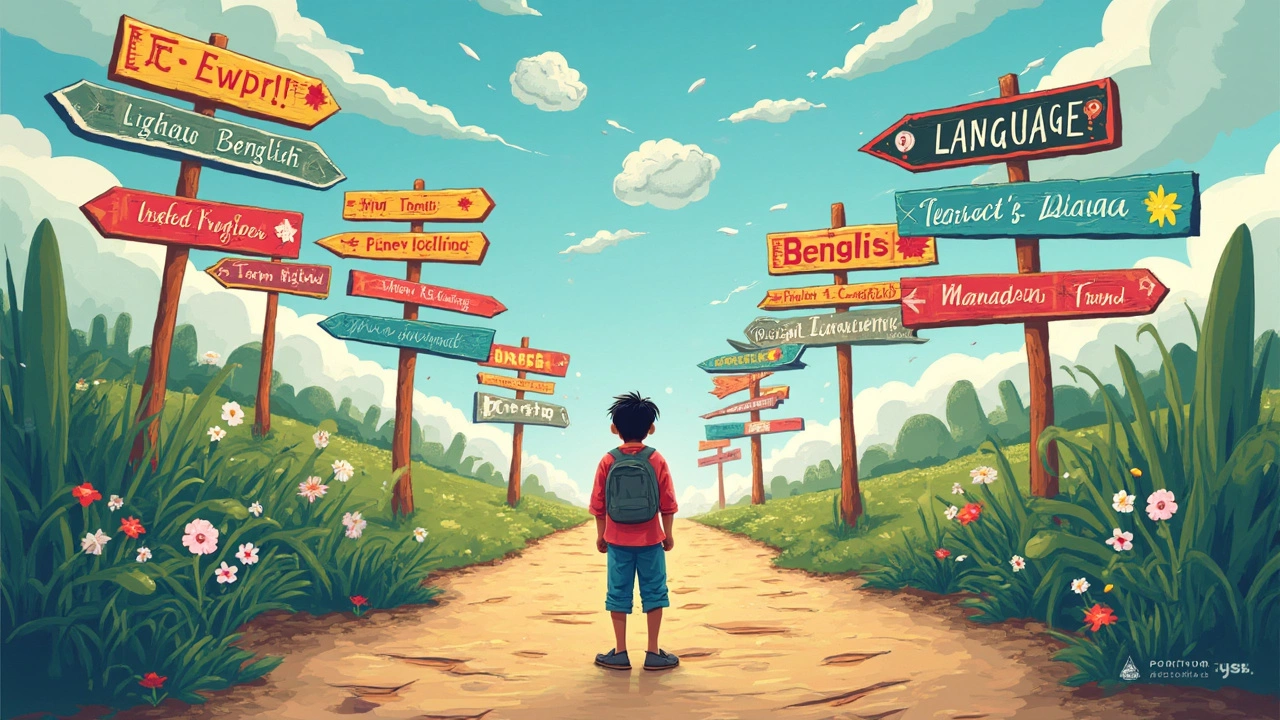Ever tried to order food in a new country and ended up getting something totally unexpected? Language is wild that way. But here’s the kicker: everyone wants to know which language is the hardest to learn—especially if you’re thinking about English courses in India. Is it Mandarin, Arabic, or something like Finnish with its 15 grammar cases? Or is English actually the sneaky boss level that trips people up?
If you think English is easy just because it’s everywhere—think again. Even though we see English signs at airports, scroll through English memes, and fill out job applications in English, tons of people still struggle with it. Stuff like weird spelling, silent letters (what’s even up with ‘knight’?), and words that sound the same but mean totally different things (bear and bare—really?). For anyone learning English in India, the game isn’t as simple as it looks, even though half the world seems to speak it in movies.
- What Makes a Language Hard to Learn?
- English: Surprisingly Tough for Indians
- Languages Even Harder Than English
- Funny Language Facts That Blow Your Mind
- Tips to Make Learning Easier
What Makes a Language Hard to Learn?
It’s easy to blame yourself when a new language feels impossible. But most of the time, it isn’t you—it’s the language. There are a few key things that make a language really tough to crack, especially if your first language is totally different.
- Grammar Rules: Some languages stack up endless rules and exceptions. Russian, for example, has six different cases. Turkish messes with your head by sticking endings everywhere. All these rules mean more memorizing and more ways to mess up.
- Pronunciation: Think English is the only one with silent letters? French has words where you barely say half the letters. Mandarin uses tones—say a word with the wrong pitch and you could call someone a horse instead of your mom. Not a fun mistake.
- Writing Systems: If you learned the alphabet in India, try getting used to Chinese characters (there are thousands) or the Arabic script that goes right to left. Reading and writing suddenly feels like code-breaking.
- Vocabulary: If the new language has zero words in common with yours, every word is from scratch. Japanese and Korean don’t share much with English or Hindi, so nothing feels familiar at first.
- Language Environment: You pick up a language faster if you hear it all day. But if you only get a couple textbook lessons each week, your brain isn’t swimming in it, so it’s harder to learn.
Here’s a cool table showing why some languages stump even native speakers of Hindi or English:
| Language | Writing System | Toughest Grammar Point | Average Time to Speak (hours) |
|---|---|---|---|
| Chinese (Mandarin) | Characters | 4 Tones, No Alphabets | 2200+ |
| Arabic | Right to Left Script | Root System | 2200+ |
| Japanese | Kanji + Kana | Particles, Formality Levels | 2200+ |
| Hindi | Devanagari | Gendered Nouns | 1100 |
| English | Latin Alphabet | Irregular Spellings | 600-750 |
As you can tell, the hardest language to learn isn’t the same for everyone. It depends on which language you already know, how much you’re surrounded by the new one, and if the grammar and sounds mess with your mind. But if you ask around, the top headaches are usually new alphabets, tricky grammar, and tongue-twisting words.
English: Surprisingly Tough for Indians
You’d think picking up English would be a walk in the park since it’s used in our schools, metros, and even courtrooms. That’s only half the story. When it comes to actually speaking, understanding, or writing “proper” English, most Indians hit more roadblocks than expected.
First off, English isn’t even in the same language family as most Indian languages. Hindi, Bengali, Telugu, and Tamil have their own structures. English grammar feels upside-down compared to what students are used to. The word order is completely different, and that trips people up every single day.
Next hurdle: pronunciation and spelling. Some English words look nothing like they sound (“colonel” or “choir,” anyone?) and silent letters make things trickier. Let’s not even talk about “through,” “though,” and “tough.” And then, Indian accents make it even messier—sometimes the stress lands on the wrong syllable and meanings slip away.
Have a look at some of the top challenges Indians face with English, backed by data:
| Challenge | % of Learners Struggling |
|---|---|
| Pronunciation | 46% |
| Grammar (like tense usage) | 39% |
| Vocabulary | 33% |
| Listening skills (global accents) | 28% |
Even learning “basic” English words can be tricky because most of us think and translate in our mother tongue first. Direct translations rarely work. For example, “passing out” in India means finishing school, but abroad it means fainting! Those little differences trip up even confident speakers.
If you really want to crack english courses in india, focus on these:
- Listen to real conversations, not just textbook audio. TV shows, podcasts, and YouTube help a lot.
- Practice talking with anyone who’ll listen—even if it’s just reading out loud to yourself.
- Pay attention to context. Same word, totally different vibe in another sentence.
Fluency isn’t just about learning fancy words or grammar. It’s about understanding the real-life quirks that come with English in India—and giving yourself time to get comfortable with them.

Languages Even Harder Than English
Think English is tough? Brace yourself. Languages like Mandarin Chinese, Arabic, and Russian take the cake for being even harder to crack for Indian learners.
Let’s get real: Mandarin Chinese, for starters, doesn’t use an alphabet. Instead, you’re expected to memorize thousands of characters. Four tones mean one word can have four totally different meanings based on how you say it. Mess up the tone, and you could end up calling someone’s mother a horse (true story).
Arabic takes the confusion up a notch. The script flows right to left, letters change shape depending on their place in a word, and there’s no easy way to connect with the sounds if you haven’t grown up hearing them. The U.S. Foreign Service Institute, which trains diplomats, puts Mandarin and Arabic in their highest category for language difficulty—meaning they take over 2,200 hours of study to get conversation-ready!
| Language | Why It's Tough |
|---|---|
| Mandarin Chinese | Tones, thousands of characters, no alphabet |
| Arabic | Script direction, morphing letters, hard sounds |
| Russian | Complex grammar, new alphabet, tongue-twisting sounds |
| Japanese | Three writing systems, vague grammar, context-heavy |
| Korean | Tricky pronunciation, new script, formal levels |
A 2023 survey by Duolingo showed that learners from India spent up to 70% more time on Mandarin lessons compared to English. No surprise, considering the difference in structure and script.
“Mandarin and Arabic require not just new vocabulary, but a completely different way of thinking about language,” says the FSI’s language program director.
Don’t get discouraged though. While these languages may sound close to impossible, there are people out there smashing these challenges every day. If you’re up for a brain workout, picking up a super-hard language can really open up your world.
But if your goal is mastering english courses in india, rest easy—there’s a reason English is a global lingua franca, even if those silent letters make you want to scream sometimes.
Funny Language Facts That Blow Your Mind
Languages have all sorts of odd tricks up their sleeve. Some are just plain funny, and others will have you questioning reality. For example, did you know that there are about 7,000 languages spoken across the world right now? But here’s the shocker—nearly half the population speaks only ten of them.
English is a classic troublemaker. The word "set" has the highest number of different meanings—over 430! That’s enough to confuse anyone, even if you’ve been speaking English for years. There are words that break every spelling rule too. Like "ghoti" could technically be pronounced "fish" if you use different English rules (gh as in enough, o as in women, ti as in nation). Wild, right?
- Chinese doesn’t really have an alphabet—just thousands of characters. You need to memorize over 3,000 just to read a newspaper.
- There’s a language in Mexico called Ayapaneco with only two speakers left—and rumor has it, they don’t talk to each other. Think about that next time someone says Hindi is dying out.
- German loves its long words. The longest word officially used in German law (before it got cancelled) was 63 letters: Rindfleischetikettierungsüberwachungsaufgabenübertragungsgesetz. No, there’s not going to be a spelling test.
- In the South African language Xhosa, there are click sounds that most of us can’t even begin to mimic on the first try.
And even hardest language to learn contenders like Japanese and Korean swap out entire writing systems depending on what they’re writing about—casual convo, formal business, or just names.
| Language | Weird Fact |
|---|---|
| English | "E" is the most used letter; over 11% of all used English letters are E. |
| Finnish | No word for "please"—they just use polite tone. |
| Arabic | Letters look different depending where they show up in a word. |
| Polish | 7 cases and tongue-twisters like "szczęście." Try saying that three times fast! |
| Mandarin | There's no real alphabet, just thousands of characters—so if you want to send a text, you’ll need some serious memory. |
The world of languages is a maze of crazy rules, wild exceptions, and stuff that just makes you laugh once you survive the confusion. No wonder picking the hardest one feels kind of impossible sometimes.

Tips to Make Learning Easier
Trying to crack a new language feels like working out at a gym you’ve never been to. You need good routines, the right attitude, and stuff that actually works. Here’s what can really help people in India get better at learning English—or honestly, any language.
- English courses in India can speed up the process. But don’t just sit in class. Practice what you learn in real life. Order coffee in English, call customer service, or join an English-speaking WhatsApp group. Use it outside the textbook.
- Beating English spelling is all about patterns, not just rules. For example, "i before e except after c"—it’s a thing, but there are exceptions like "weird" and "neither." Stick sticky notes around your house with tricky spellings. Visual memory helps big time.
- Watch shows or YouTube channels with subtitles. Platforms like Netflix, Hotstar, and even Instagram reels are more helpful than old school grammar books. You hear how words sound and see how sentences fit together.
- Talk to yourself in English. Sounds weird, works wonders. Describe what you’re doing—like "I am making chai," or "I lost my phone again." It gets you comfortable building sentences without freezing up in conversations.
- Apps like Duolingo, Memrise, and HelloTalk give you short bursts of practice that fit into your commute or while waiting in line. They make learning less of a chore and more like a quick game.
- Don’t stress over mistakes. Even native speakers flop grammar sometimes. The more you mess up, the faster you get it right next time. That’s how your brain wires the language.
- Set tiny goals. Try using five new words a day at work or with friends. Small wins give you confidence, and that’s what keeps you moving.
If you keep showing up and keep using what you know, you’ll find that even the hardest language loses its bite over time.
